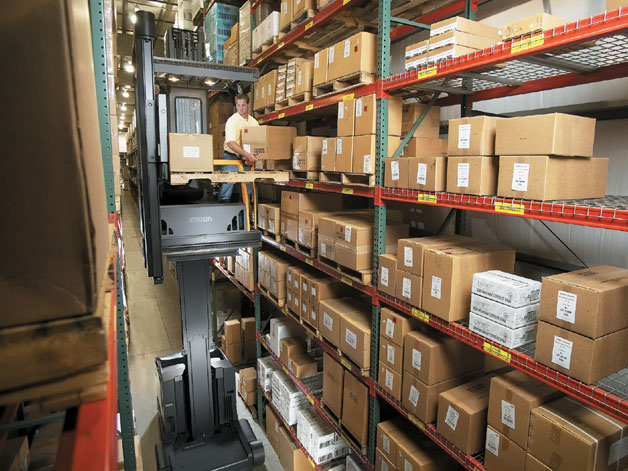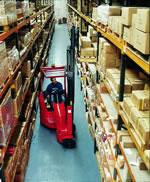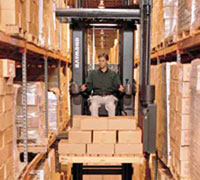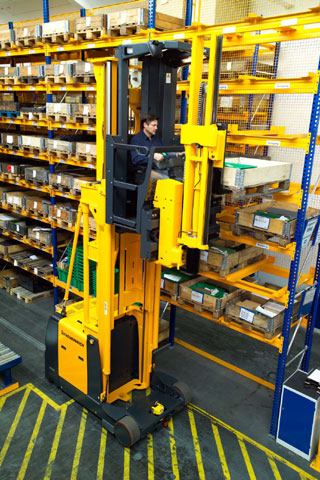 Crown's TSP6000 series turret stockpicker |
Warehouse operations are essential in the supply chain. The ability to quickly and accurately move warehouse contents keeps stock moving and businesses thriving.
Forkliftaction.com News reporter
Christine Liew reports on the forklifts that help pick and shift stock in very narrow aisles.
Turret trucks and order pickers, or very narrow aisle (VNA) forklifts, are the most sophisticated and costly of warehouse forklifts. VNA forklifts can reach up to 16 metres and, depending on load sizes, generally work in aisles 1.4 metres to 1.8 metres wide. Priced up to five times more than counterbalanced forklifts, VNA trucks can stack pallets, order pick and maximise warehouse space.
VNA trucks are different to other warehouse forklifts, like counterbalanced forklifts and reach trucks, because they turn only the load while other forklifts turn the entire vehicle in the aisle. However, manufacturers like Narrow Aisle, in the UK, and Landoll Corp (the Bendi), of Kansas, USA, have developed articulated trucks that can work in aisles as narrow as 1.6 metres.
Flexi a two-truck substituteNarrow Aisle Ltd, of West Midlands, UK, demonstrated its latest articulated forklift, the Flexi G4, at IMHX 2007 in Birmingham this month.
VNA forklifts generally work only inside warehouses and are not designed to load or unload trailers. But Narrow Aisle's Flexi, which lifts up to 11 metres, is a non-standard VNA vehicle.
 The Flexi |
Narrow Aisle sales & marketing director John Maguire said the Flexi substituted a two-truck system. "Articulated trucks load and unload lorries and deliver pallets directly to the racking in a single operation.
"This ability to load like a counterbalanced truck, combined with a capacity to work comfortably inside and outside and in very narrow aisles, has established the articulated truck as a popular choice in a wide range of industries," he said.
Unlike standard VNA trucks, the Flexi, a very compact forklift, enters an aisle with the palletised load at the front and then articulates before turning the pallet through 90 degrees to put it away. It works outside like a counterbalanced forklift but does not require the same aisle width.
VNAs trend to higher lift heights Raymond Corp's order picker & VNA products director Susan Comfort, based in Greene, New York, US, said the past five to 10 years had seen narrow aisle forklifts trending to higher lift heights.
 Raymond's Swing-Reach truck |
"It is less expensive to build up than to build out.
"VNA trucks are very functional for high-density storage. For example, when using a Raymond Swing-Reach truck with racks at more than 12 metres and aisles of 1.8 metres, you can store two-thirds more pallets than a counterbalanced truck stacking four levels in the same footprint."
She said VNA forklifts were not suited for "unloading trailers or horizontal transport".
Safety the primary considerationSafety was a main concern in designing VNA trucks, said Hamburg, Germany-headquartered Jungheinrich AG's head of product for warehouse technology, Sebastian Riedmaier.
He said Jungheinrich had about a 30 per cent share of the European VNA forklift market. He estimated the European market size at 6,300 trucks in 2006, up from 5,400 trucks five years ago. "The economy is growing and there are new markets in Eastern Europe."
While there were many safety issues for VNA forklifts, "too many to describe completely", he was adamant they were not "unsafe" vehicles.
"You are going very near to racks and driving down the aisle at 10km/h and going up the cabin with only 10cm between you and the racks, so safety is very important," Riedmaier said.
Because of safety issues, the turret truck was "the hardest warehouse forklift to design", he said.
Balance safety and productivityNarrow Aisle's Maguire said there needed to be a balance between productivity and safety.
"While there is always a temptation to condense aisles to the narrowest possible width, safety has to be the foremost consideration with any new warehouse scheme."
He said the British Industrial Truck Association introduced Guidance Note 9 (GN9) in 1999 that determined the minimum aisle width based on the type and combination of forklifts used. The guideline had originally been endorsed for sites where counterbalanced forklifts and reach trucks were used but could also apply for VNA forklifts.
GN9 outlined the ideal aisle width in which a forklift and a pallet could turn safely. For reach trucks, the measurement was calculated on the assumption the pallet was at ground level when it was picked up and turned at 90 degrees in the aisle before the load was raised.
Maguire said, when assessing the ideal aisle width for articulated trucks to conform to GN9, the most important dimension was the diagonal distance across the pallet, from one corner to another, when the pallet was rotated in the aisle.
"Safety clearance of 10cm either side of a typical pallet will need to be added to ensure pallet put-away and retrieval.
"We recommend, for applications where standard UK pallets are used, that aisle widths be at least 1.762 metres to conform to GN9. This is still considerably less space than a reach truck requires to operate but it does not compromise safety," he said.
Floor flatness vitalAnother important safety and productivity requirement for VNA forklifts is the floor they work on, more specifically its flatness.
Riedmaier said when Jungheinrich customers wanted to buy VNA trucks, they received specific information on how to construct the warehouse floor according to DIN (German Industrial Standard) 15185.
"VNA trucks have a safety distance to the left and right of only 10cm. If you go up 12, 13 metres and the floor is uneven, the truck starts to swing and go into racks.
"Then there are accidents," he said.
Among other requirements, the German Industrial Standard says a narrow aisle warehouse floor must not deform under load and that shafts, channels or similar breaks in the floor must be arranged with a minimum distance of 20cm from the tracks. Such installations in the working aisle should generally be avoided.
If the minimum requirements of DIN 15185 were regarded, VNA trucks' full capacity (lift heights of up to about 15 metres and speeds to about 12 km/h) could be realised.
Riedmaier said "in most cases", the full speed of VNA forklifts was not used.
"In some cases, where you have bad floors, the truck reduces speed in all aisles."
Guidance aids productivityWarehouses generally use systems like mechanical (rails and rollers) or inductive (electromagnetic field) guidance to help guide VNA forklifts along the aisles, enabling them to operate safely and productively at high speeds without operator intervention.
However, use of guidance systems to enable quick, efficient movement along narrow aisles was often hampered by uneven floors.
RFID linked to floor topology Jungheinrich's new EKX range truck. |
Jungheinrich's newest VNA forklift, the EKX order picker/stacker Kombi, launched at LogiMAT in Stuttgart, in February, uses RFID floor control to enhance the truck's performance and safety.
"It's like GPS for the truck but GPS comes from heaven. This GPS comes from the floor, through the trucks' transponder, which we set on the floor," Riedmaier said.
The RFID floor control system is linked to the floor topology. Information on the topology is stored in the forklift's memory and used to adjust speed and control parameters. The forklift automatically slows down when it reaches the end of an aisle and reduces speed in poor quality floor areas or when carrying sensitive goods.
"The transponders will tell the truck, for example, in aisles four and five, there are bad floors, please reduce the speed there," Riedmaier said. The system enabled the forklift to reduce speed only in aisles with poor floor conditions.
Differences between VNA forklifts and automated guided vehicles (AGVs), according to Riedmaier:- AGV is an automatic system, VNA is man-operated;
- The initial investment in an AGV warehouse system is thrice the investment in a VNA warehouse system;
- AGV is less flexible than VNA. AGVs cannot order pick and require pallets to be similarly sized and accurately positioned; and
- AGVs can go higher than 30 metres. VNA's physical limit is about 15 metres, although Yale's MTC series of man-up turret trucks can lift up to 16 metres.
Use of a VNA or AGV system in a warehouse depends on individual customers' requirements. AGVs are good transporters but cannot perform order picking. Their lack of flexibility does not allow adaptation to changing load sizes. But they can complement VNA forklifts by transporting pallets to and from a narrow aisle area, keeping the VNA forklifts working in the narrow aisles.
Other VNA forklift brands include Crown, Atlet, Linde, Rocla, Om Pimespo, Drexel SwingMast, Hyster, Yale and Mitsubishi.